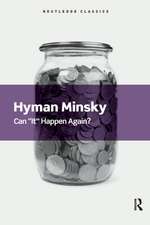The Paretian Tradition During the Interwar Period: From Dynamics to Growth: Routledge Studies in the History of Economics
Autor Mario Pominien Limba Engleză Hardback – 19 mai 2014
In the 1930s, the concept of dynamic equilibrium became the main research field of the Pareto school which gave its most important contributions in this field. The Paretian economists as Amoroso, de Pietri Tonelli, Sensini, and the younger, such as Bordin, Palomba, La Volpe, Fossati and Zaccagnini, for the most part students of the former, developed this approach in many directions. The theory of dynamic equilibrium reached remarkable results from an analytical viewpoint through the wide application of the functional calculus, thus anticipating a perspective which was taken into consideration in the 1960s with the theory of optimal growth. Despite the Pareto school’s relevance, it remained widely unknown, not only at international level, but also in Italy. Recently, it has been object of renewed interest. This present work aims at reconstructing the fundamental contributions offered by the Pareto school in forming the economic dynamics theory.
Din seria Routledge Studies in the History of Economics
-
 Preț: 378.26 lei
Preț: 378.26 lei -
 Preț: 316.51 lei
Preț: 316.51 lei -
 Preț: 302.55 lei
Preț: 302.55 lei - 9%
 Preț: 1003.12 lei
Preț: 1003.12 lei -
 Preț: 324.46 lei
Preț: 324.46 lei -
 Preț: 311.28 lei
Preț: 311.28 lei -
 Preț: 326.99 lei
Preț: 326.99 lei -
 Preț: 326.82 lei
Preț: 326.82 lei -
 Preț: 665.69 lei
Preț: 665.69 lei - 9%
 Preț: 935.40 lei
Preț: 935.40 lei -
 Preț: 395.82 lei
Preț: 395.82 lei -
 Preț: 280.74 lei
Preț: 280.74 lei -
 Preț: 318.31 lei
Preț: 318.31 lei -
 Preț: 392.72 lei
Preț: 392.72 lei - 8%
 Preț: 392.82 lei
Preț: 392.82 lei -
 Preț: 310.43 lei
Preț: 310.43 lei -
 Preț: 214.15 lei
Preț: 214.15 lei -
 Preț: 399.71 lei
Preț: 399.71 lei -
 Preț: 157.37 lei
Preț: 157.37 lei - 26%
 Preț: 850.91 lei
Preț: 850.91 lei - 27%
 Preț: 995.39 lei
Preț: 995.39 lei - 18%
 Preț: 1005.04 lei
Preț: 1005.04 lei - 18%
 Preț: 1002.60 lei
Preț: 1002.60 lei - 28%
 Preț: 1046.46 lei
Preț: 1046.46 lei - 18%
 Preț: 1280.31 lei
Preț: 1280.31 lei - 18%
 Preț: 1055.51 lei
Preț: 1055.51 lei - 18%
 Preț: 1055.51 lei
Preț: 1055.51 lei - 28%
 Preț: 987.72 lei
Preț: 987.72 lei - 25%
 Preț: 824.17 lei
Preț: 824.17 lei - 18%
 Preț: 1061.93 lei
Preț: 1061.93 lei - 18%
 Preț: 716.32 lei
Preț: 716.32 lei - 18%
 Preț: 1006.07 lei
Preț: 1006.07 lei - 18%
 Preț: 1069.92 lei
Preț: 1069.92 lei - 12%
 Preț: 342.67 lei
Preț: 342.67 lei - 18%
 Preț: 1056.00 lei
Preț: 1056.00 lei - 28%
 Preț: 991.34 lei
Preț: 991.34 lei - 18%
 Preț: 1076.53 lei
Preț: 1076.53 lei - 18%
 Preț: 698.08 lei
Preț: 698.08 lei - 22%
 Preț: 332.02 lei
Preț: 332.02 lei - 18%
 Preț: 1169.78 lei
Preț: 1169.78 lei - 18%
 Preț: 1059.84 lei
Preț: 1059.84 lei - 30%
 Preț: 852.88 lei
Preț: 852.88 lei - 25%
 Preț: 830.10 lei
Preț: 830.10 lei - 18%
 Preț: 1119.93 lei
Preț: 1119.93 lei - 18%
 Preț: 1062.98 lei
Preț: 1062.98 lei - 18%
 Preț: 953.01 lei
Preț: 953.01 lei
Preț: 1164.92 lei
Preț vechi: 1420.64 lei
-18% Nou
Puncte Express: 1747
Preț estimativ în valută:
222.94€ • 231.89$ • 184.05£
222.94€ • 231.89$ • 184.05£
Carte tipărită la comandă
Livrare economică 14-28 aprilie
Preluare comenzi: 021 569.72.76
Specificații
ISBN-13: 9780415661409
ISBN-10: 0415661404
Pagini: 178
Dimensiuni: 156 x 234 x 15 mm
Greutate: 0.49 kg
Ediția:1
Editura: Taylor & Francis
Colecția Routledge
Seria Routledge Studies in the History of Economics
Locul publicării:Oxford, United Kingdom
ISBN-10: 0415661404
Pagini: 178
Dimensiuni: 156 x 234 x 15 mm
Greutate: 0.49 kg
Ediția:1
Editura: Taylor & Francis
Colecția Routledge
Seria Routledge Studies in the History of Economics
Locul publicării:Oxford, United Kingdom
Public țintă
Postgraduate and UndergraduateCuprins
Introduction 1. The Paretian School in Italy 2. Pareto’s legacy in economic dynamics 3. Dynamic equilibrium in the international context 4. Dynamic equilibrium and economic mechanics in Luigi Amoroso 5. Dynamic equilibrium and expectations in Giulio la Volpe 6. Eraldo Fossati and the role of uncertainty 7. Dynamic equilibrium and economic cycle 8. From dynamic equilibrium to the theory of optimal growth
Descriere
This book analyzes the evolution of the approach of dynamic equilibrium between the two world wars. Focusing on its intellectual history, it describes precisely how the central idea of equilibrium dynamics was advanced and mathematically formulated in the years of high theory in an international context, explaining clearly the creation of economic dynamics in the context of its historical development.














